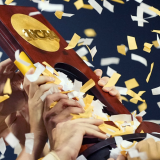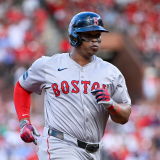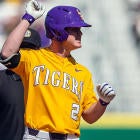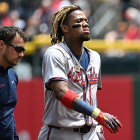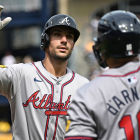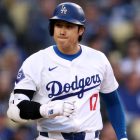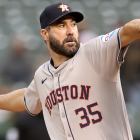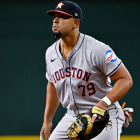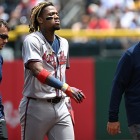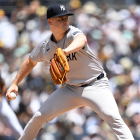The 2020 MLB amateur draft is underway. The two-day event opened Wednesday night with the first round and Competitive Balance Round A. There were 37 picks made on Day 1, starting with the Tigers making Arizona State Slugger Spencer Torkelson the No. 1 pick. The remaining 123 picks of the five-round draft will be made Thursday. Here's how you can watch Day 2.
Thirty-five of R.J. Anderson's top 50 draft prospects were selected Wednesday, so there are still many quality players on the board going into Thursday's action. It should be noted the top available high schoolers may not be signable at this point. There may not be enough bonus pool money available to buy them away from college, in which case they'll simply go undrafted.
Here are the top players available on Day 2 according to Anderson's top 50 rankings. Teams will spend Thursday morning talking to these players and trying to pin down everyone's willingness to sign, and their bonus demands.
Jared Kelley, RHP, Refugio High School (TX)
No. 22 in pre-draft ranking: Kelley's physicality is unmatched among prep arms. He's big and stout and looks like he could give a team seven strong if he was given a day's notice. He's likely to be one of the first prep arms off the board on draft day thanks to his mid-to-upper-90s fastball and a high-grade changeup. Typically, the top high-school arms have a breaking ball as their best secondary pitch. That jives with the rule of thumb that states any pitcher can be taught a changeup with enough repetitions, but that spinning the ball is an innate skill. (It would be fair to propose that he could just learn a cutter if his breaker fails to materialize.) Kelley has one other notable concern working against him that isn't his fault: the failures of pop-up prep arms in recent years. Maybe Kelley will turn into the next Tyler Kolek. Some team will gladly take that chance.
Chris McMahon, RHP, Miami
No. 23 in pre-draft ranking: McMahon, a three-sport athlete in high school, has the potential to make a team happy in the later portions of the first round. He could have three above-average offerings at his maturation, with a good fastball and changeup and a promising breaking ball. Over the course of his collegiate career, he struck out more than a batter per inning and proved to be difficult to square up, as he allowed just four home runs in 112 innings. McMahon did miss time as a freshman due to a knee injury, and his delivery features a high elbow that could ostensibly cause him harm down the road. Still, he should be a quick-moving big-league contributor with upside.
J.T. Ginn, RHP, Mississippi State
No. 24 in pre-draft ranking: Ginn entered the spring as a potential top-10 pick on the strength of his fastball-slider pairing and his freshman season with the Bulldogs (3.13 ERA and 5.53 strikeout-to-walk ratio). Unfortunately, his lofty standing lasted as long as his season did: a single start. He underwent Tommy John surgery in early March, right before the spread of the novel coronavirus, and he likely won't return to the mound until next summer. Scouts believe he's likely to go high enough to justify signing. He's a draft-eligible sophomore, so don't expect him to come super cheaply.
Daniel Cabrera, OF, LSU
No. 25 in pre-draft ranking: LSU has produced a number of passable big-league outfielders over the past decade, including Mikie Mahtook, Andrew Stevenson, JaCoby Jones, and Jake Fraley. Cabrera likely isn't going to alter a franchise, or make All-Star Games, but he should be viewed as a potential no-frills starting left fielder. His contact-heavy approach worked well enough in both the SEC (.305/.392/.518) and in last summer's Cape Cod League (.287/.369/.400) to assure an early selection.
Cole Wilcox, RHP, Georgia
No. 30 in pre-draft ranking: For as good as Hancock was during the abbreviated season, it was Wilcox who led the Bulldogs in strikeout-to-walk ratio (16). That accomplishment was a departure from the wildness he showed during his freshman and Cape Cod League efforts, when he walked nearly 15 percent of the batters he faced. Wilcox has top-shelf arm strength, and a promising slider. His delivery features enough effort that scouts think he'll wind up in the bullpen, but he should get a chance to start at the onset of his career.
Logan Allen, LHP, FIU
No. 33 in pre-draft ranking: Allen has a common name for baseball players, but he has an uncommon profile for this list. He's on the short and lean side (6-foot, 180 pounds) with a fastball on the slow side (low-90s). Yet Allen could go earlier than his raw stuff indicates he should because of his polish. He has good command, a plus changeup, and the utmost confidence in his ability on the mound. He isn't going to be anyone's ace, but he knows how to pitch and should reach the majors quickly.
Clayton Beeter, RHP, Texas Tech
No. 37 in pre-draft ranking: Beeter is one of the most intriguing arms in the class. During an uneven freshman season spent in relief, he struck out (40) or walked (20) more than 64 percent of the batters he faced. Beeter joined the rotation this season, and he showed much improved control over four starts. His stuff is beyond questioning: his Trackman metrics are absurd, with his curveball possessing spin rates that would be elite among big-league pitchers; his command is more suspect, and his arm is often late to get up. A team enamored by his upside could pop him earlier than his track record suggests, but they'll do so knowing he could just be a reliever when all is said and done.
Dax Fulton, LHP, Mustang High School (OK)
No. 38 in pre-draft ranking: Fulton underwent Tommy John surgery last September, but he could still be picked by a team willing to buy him out of his Oklahoma commitment. He possesses several of the foundational building blocks teams look for in starters: a big frame; a good fastball; a promising curveball; and so on. A team with multiple early round picks seems likeliest to pull the trigger.
Carson Montgomery, RHP, Windermere High School (FL)
No. 39 in pre-draft ranking: Montgomery already possesses a starter's frame, at 6-foot-2 and nearly 200 pounds. He has other innate qualities teams desire in their rotation arms, too, like the raw spin on his pitches and the ability to touch the mid-90s with his fastball. Montgomery will need to work on his changeup and his command, and he'll have to be convinced to leave his Florida State commitment in the past, but whatever team commits could benefit in the long run.
Masyn Winn, SS/RHP, Kingwood High School (TX)
No. 42 in pre-draft ranking: If a position player selected outside of the first round is going to turn into a star, it might be Winn. He's an absolute toolshed; a two-way player with an Arkansas commitment who could become a notable player on either side of the ball. Winn pairs near-elite bat speed with average strength. He swings and misses a fair amount, but he counterbalances that tendency with an athletic profile that could see him develop into an above-average shortstop and baserunner. Winn is raw, and some prefer him as a pitcher, but he's a deep cut of a name to keep in mind.
Casey Martin, SS/OF, Arkansas
No. 46 in pre-draft ranking: Martin is a tantalizing talent. He has above-average power and top-of-the-scale speed; he hit .310/.389/.542 over three years in the SEC; and he should play a premium position (likely center field). Why is he ranked this low? Because Martin has well-below-average pitch recognition and is helpless against breaking balls. He struck out in more than 24 percent of his career plate appearances (including 30 percent in 2020), and finished with a 2.46 strikeout-to-walk ratio. Will Wilson, who went 15th last June to the Los Angeles Angels, was considered risky because of his 1.61 strikeout-to-walk ratio. (The Angels traded Wilson over the winter to dump Zack Cozart's contract.) Martin's potential is immense; so are his odds of realizing it.
Dillon Dingler, C, Ohio State
No. 47 in pre-draft ranking: Dingler, a converted outfielder, was on his way to a banner year when the season was canceled. In 13 games, he'd hit .340/.404/.760 with nearly as many homers (five) as strikeouts (seven). Dingler has the arm strength and the athleticism to stick behind the plate. His lacking exit velocity and track record means a team will have to be confident to take him in the first round.
Jared Jones, RHP, La Mirada High School (CA)
No. 49 in pre-draft ranking: Baseball is in Jones' blood. His father played in the Arizona Diamondbacks organization; his mother was a collegiate softball player; and two of his cousins (Randy and Ron Flores) pitched in the majors. Predictably, Jones is a stellar athlete who has also impressed in the outfield with his arm and legs. On the mound, he's been clocked up to 98 mph, and he's shown the makings of an above-average slider. Jones is even willing to tinker with the tempo of his delivery, a la Marcus Stroman or Johnny Cueto, to disrupt hitters' timing. Because he's just 6-foot-1, and because his delivery requires effort, some scouts think he'll end up in the bullpen. His youth, athleticism, and upside will convince a team to let him begin his career in a rotation.
Burl Carraway, LHP, Dallas Baptist
No. 50 in pre-draft ranking: Everyone else on this list is a reliever as a fallback option. Not Carraway. He pitched out of the bullpen in 37 of his 38 appearances at Dallas Baptist, and he is certain to remain in that role as a professional. Carraway has an upper-90s fastball and a slow curve that he used to great effect for the Patriots, striking out 15.6 batters per nine for his career. He does have below-average command (which might not surprise anyone who has seen his high-tempo, crossfire delivery), and he'll need to find the zone more often as he progresses. The upside here is a quick-moving late-inning dynamo, and with due respect to CJ Van Eyk and Tommy Mace and the other capable starters who could easily slot in here, that's likely to get him popped sometime over the first 50 picks.
Other notable available players
- Jordan Blaze, 3B, DeSoto Central High School (Mississippi)
- Cole Henry, RHP, LSU
- Cade Horton, SS, Norman High School (Oklahoma)
- Kevin Parada, C, Loyola High School (California)
- C.J. Van Eyk, RHP, Florida State









